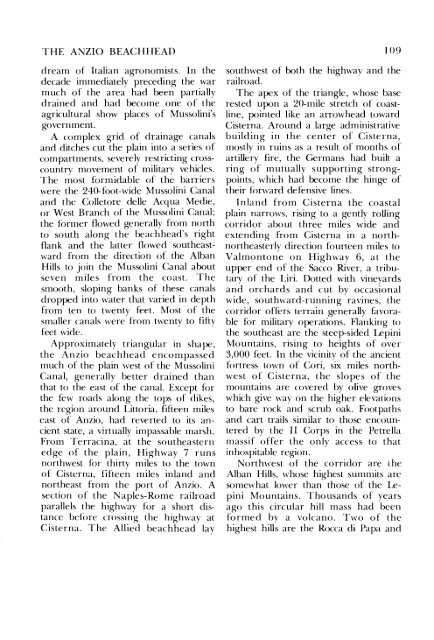Cassino to the Alps - US Army Center Of Military History
Cassino to the Alps - US Army Center Of Military History
Cassino to the Alps - US Army Center Of Military History
Create successful ePaper yourself
Turn your PDF publications into a flip-book with our unique Google optimized e-Paper software.
THE ANZIO BEACHHEAD<br />
dream of Italian agronomists. In <strong>the</strong><br />
decade immediately preceding <strong>the</strong> war<br />
much of <strong>the</strong> area had been partially<br />
drained and had become one of <strong>the</strong><br />
agricultural show places of Mussolini's<br />
government.<br />
A complex grid of drainage canals<br />
and ditches cut <strong>the</strong> plain in<strong>to</strong> a series of<br />
compartments, severely restricting crosscountry<br />
movement of military vehicles.<br />
The most formidable of <strong>the</strong> barriers<br />
were <strong>the</strong> 240-foot-wide Mussolini Canal<br />
and <strong>the</strong> Colle<strong>to</strong>re delle Acqua Medie,<br />
or West Branch of <strong>the</strong> Mussolini Canal;<br />
<strong>the</strong> former flowed generally from north<br />
<strong>to</strong> south along <strong>the</strong> beachhead's right<br />
flank and <strong>the</strong> latter flowed sou<strong>the</strong>astward<br />
from <strong>the</strong> direction of <strong>the</strong> Alban<br />
Hills <strong>to</strong> join <strong>the</strong> Mussolini Canal about<br />
seven miles from <strong>the</strong> coast. The<br />
smooth, sloping banks of <strong>the</strong>se canals<br />
dropped in<strong>to</strong> water that varied in depth<br />
from ten <strong>to</strong> twenty feet. Most of <strong>the</strong><br />
smaller canals were from twenty <strong>to</strong> fifty<br />
feet wide.<br />
Approximately triangular in shape,<br />
<strong>the</strong> Anzio beachhead encompassed<br />
much of <strong>the</strong> plain west of <strong>the</strong> M ussolini<br />
Canal, generally better drained than<br />
that <strong>to</strong> <strong>the</strong> east of <strong>the</strong> canal. Except for<br />
<strong>the</strong> few roads along <strong>the</strong> <strong>to</strong>ps of dikes,<br />
<strong>the</strong> region around Lit<strong>to</strong>ria, fifteen miles<br />
east of Anzio, had reverted <strong>to</strong> its ancient<br />
state, a virtually impassable marsh.<br />
From Terracina, at <strong>the</strong> sou<strong>the</strong>astern<br />
edge of <strong>the</strong> plain, Highway 7 runs<br />
northwest for thirty miles <strong>to</strong> <strong>the</strong> <strong>to</strong>wn<br />
of Cisterna, fifteen miles inland and<br />
nor<strong>the</strong>ast from <strong>the</strong> port of Anzio. A<br />
section of <strong>the</strong> Naples-Rome railroad<br />
parallels <strong>the</strong> highway for a short distance<br />
before crossing <strong>the</strong> highway at<br />
Cisterna. The Allied beachhead lay<br />
109<br />
southwest of both <strong>the</strong> highway and <strong>the</strong><br />
railroad.<br />
The apex of <strong>the</strong> triangle, whose base<br />
rested upon a 20-mile stretch of coastline,<br />
pointed like an arrowhead <strong>to</strong>ward<br />
Cisterna. Around a large administrative<br />
building in <strong>the</strong> center of Cisterna,<br />
mostly in ruins as a result of months of<br />
artillery fire, <strong>the</strong> Germans had built a<br />
ring of mutually supporting strongpoints,<br />
which had become <strong>the</strong> hinge of<br />
<strong>the</strong>ir forward defensive lines.<br />
Inland from Cisterna <strong>the</strong> coastal<br />
plain narrows, rising <strong>to</strong> a gently rolling<br />
corridor about three miles wide and<br />
extending from Cisterna in a northnor<strong>the</strong>asterly<br />
direction fourteen miles <strong>to</strong><br />
Valmon<strong>to</strong>ne on Highway 6, at <strong>the</strong><br />
upper end of <strong>the</strong> Sacco River, a tributary<br />
of <strong>the</strong> Liri. Dotted with vineyards<br />
and orchards and cut by occasional<br />
wide, southward-running ravines, <strong>the</strong><br />
corridor offers terrain generally favorable<br />
for military operations. Flanking <strong>to</strong><br />
<strong>the</strong> sou<strong>the</strong>ast are <strong>the</strong> steep-sided Lepini<br />
Mountains, rising <strong>to</strong> heights of over<br />
3,000 feet. In <strong>the</strong> vicinity of <strong>the</strong> ancient<br />
fortress <strong>to</strong>wn of Cori, six miles northwest<br />
of Cisterna, <strong>the</strong> slopes of <strong>the</strong><br />
mountains are covered by olive groves<br />
which give way on <strong>the</strong> higher elevations<br />
<strong>to</strong> bare rock and scrub oak. Footpaths<br />
and cart trails similar <strong>to</strong> those encountered<br />
by <strong>the</strong> II Corps in <strong>the</strong> Petrella<br />
massif offer <strong>the</strong> only access <strong>to</strong> that<br />
inhospitable region.<br />
Northwest of <strong>the</strong> corridor are lhe<br />
Alban Hills, whose highest summits are<br />
somew hat lower than those of <strong>the</strong> Lepini<br />
Mountains. Thousands of years<br />
ago this circular hill mass had been<br />
formed by a volcano. Two of <strong>the</strong><br />
highest hills are <strong>the</strong> Rocca di Papa and
















